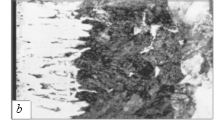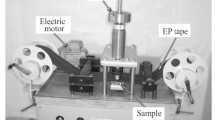Conclusions
-
1.
The chemical composition of carbon steels and low alloyed steels has no significant effect on the diffusion rate of boron.
-
2.
The borating rate decreases with increasing amounts of carbon in the steel and becomes higher than the ordinary rate only after a prolonged borating time.
-
3.
The amounts of carbon and alloyed elements in the steel have no effect on the main phase composition of the borated layer but change its structure and the quantitative ratio between the phases in the layer.
-
4.
The migration of carbon from the borted layer into the sample changes the chemical composition and the properties of the transition zone and equalizes the conditions for the diffusion of boron in steels containing different amounts of carbon.
Similar content being viewed by others
Literature cited
V. D. Taran and L. P. Skugorova, MiTOM, 6 (1957); Vestnik mashinostroeniya, 5 (1957).
M. E. Blanter and P. P. Besedin, MiTOM, 6 (1955).
I.E. Kontorovich and M. Ya. L'vovskii, Metallurg, 10–11 (1939).
Yu. M Lakhtin and M. A. Pchelkina, MiTOM, 3 (1961); Coll: Metal Science and Treatment of Metals [in Russian], Moscow, Mashgiz (1960).
A. P. Gulyaev, Heat Treatment of Steel [in Russian] Moscow, Mashgiz (1960).
Additional information
Translated from Metallovedenie i Termicheskaya Obrabotka Metallov, No. 12, pp. 39–41, December, 1964
Rights and permissions
About this article
Cite this article
Balter, M.A., Dukarevich, I.S. & Gol'dshtein, L.Y. Phase composition of borated layers of steels. Met Sci Heat Treat 6, 750–753 (1965). https://doi.org/10.1007/BF00660236
Issue Date:
DOI: https://doi.org/10.1007/BF00660236




